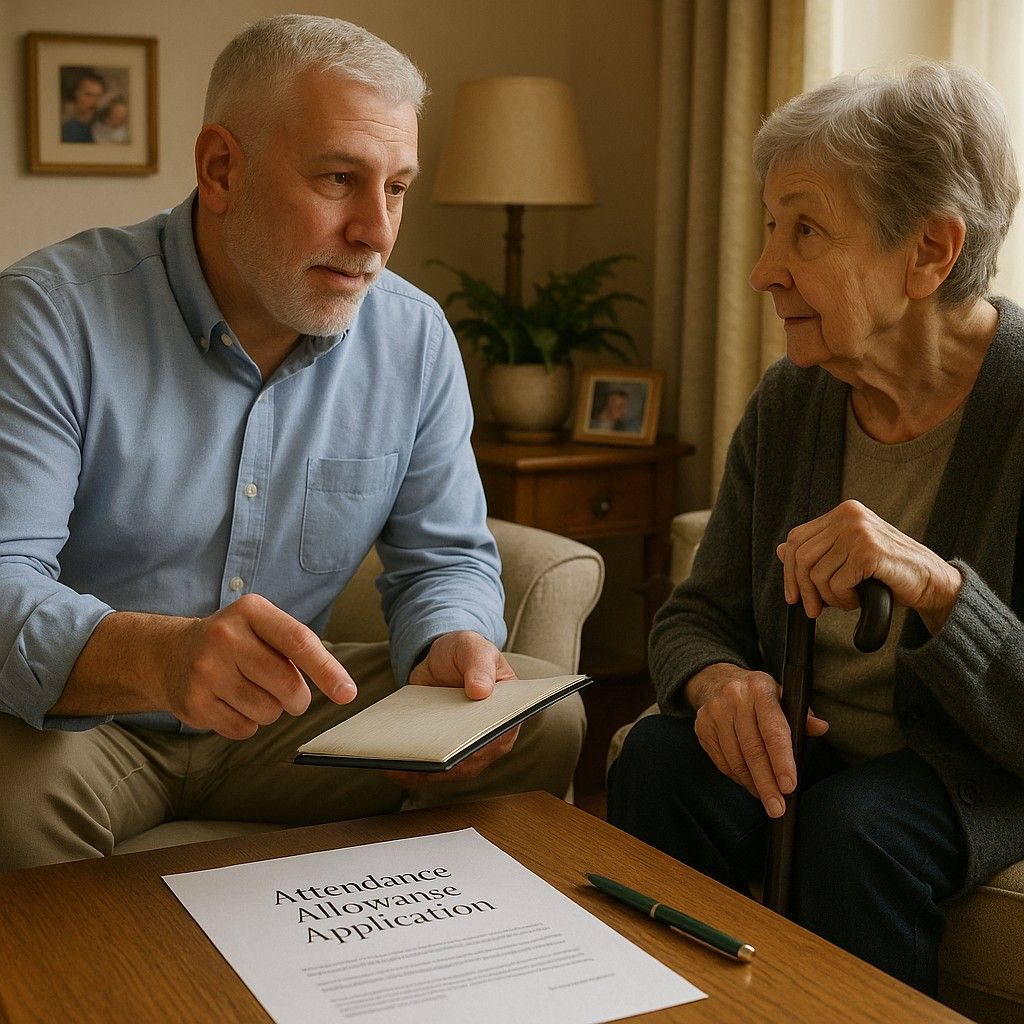Your guide to Attendance Allowance

Chris Watts: MSWW, CeMAP
Fern Wills & LPAs
Last verified: 1st October 2025 (England & Wales)
Quick-read summary 📝
Attendance Allowance is a tax-free, non-means-tested benefit for people aged 65 or over who require assistance due to illness or disability.
- It doesn’t matter what your income or savings are.
- You don’t need a carer — the allowance is based on your needs, not who provides support.
- Payments are made every 4 weeks or, if you prefer, monthly.
Practical checklist
You may be eligible for Attendance Allowance if you:
- Are over State Pension age.
- Have care or supervision needs because of a physical or mental health condition.
- Need help with personal care, supervision for safety, or managing medication.
- Have had these needs for at least six months (unless you are terminally ill).
Payment levels (from April 2025):
- Lower rate: £74.30 per week
- Higher rate: £110.40 per week
What to consider
- Application process: The AA1 form is 28–30 pages and can feel overwhelming. Many applicants under-report their needs, which risks rejection. Getting it right can unlock vital support.
- No carer required: You don’t need to have a named carer to qualify; it’s about your care needs.
- Impact on other benefits: Attendance Allowance can unlock further entitlements (e.g. extra Pension Credit, Council Tax Reduction).
- Backdating: Claims are usually backdated to when the application was received. If you phoned to request the form and returned it within six weeks, it can be backdated to the date of your request.
- Professional help: Some people complete the form themselves, others get support to present their case more effectively.
How this works in real life
Example 1: Claire (not her real name)
I visited a client, Claire. She’d left her ID on the sideboard and tried to get up from her chair to fetch it. I noticed her struggling, so I quickly offered to get it for her rather than let her strain.
She explained she often needed help around the house, for example, using both hands to push herself up from a chair and relying on a stick to move about. I suggested introducing her to one of our trusted advisers who specialises in Attendance Allowance claims.
After a free 30-minute consultation, Claire applied. She was awarded the higher rate (£110.40 per week) and her claim was backdated to when her form was submitted. The backdated amount more than covered all the professional fees, including the Attendance Allowance consultation, her Wills, and her Lasting Powers of Attorney. Additionally, she still had the ongoing allowance to enhance her quality of life.

Example 2: John and Susie
Another couple, John and his wife, Susie, spent much of their day travelling to support John’s elderly mother. They were happy to do it, but the constant “in and out” was affecting John’s ability to run his business, and it wasn’t sustainable in the long term.
I suggested a no-obligation video consultation with our trusted adviser. After the consultation, John’s mother applied and was awarded the lower rate (£74.30 per week). Since the form had been returned within six weeks of being requested, her claim was also backdated to the date of the request.
The backdated amount more than covered all the professional fees — including the Attendance Allowance consultation, the Wills, and the Lasting Powers of Attorney. And she still received the weekly allowance going forward, which covered ongoing support. This meant John and Susie could enjoy more relaxed, quality time with his mother, sharing tea and conversation, instead of always being preoccupied with cooking, cleaning, or worrying about logistics.

Frequently asked questions
Do I need a diagnosis to claim?
No. It’s about your actual care needs, not just whether you have a diagnosis.
Does having savings stop me from claiming?
No. Attendance Allowance is not means-tested, so your income and savings don’t matter.
Can it affect my pension or tax?
No. It’s tax-free and does not reduce your State Pension.
What if my condition changes?
If your needs increase, you can reapply for a higher rate.
Is there a deadline for applying?
No, but the sooner you apply, the sooner payments can begin. Claims are usually backdated to the date the DWP received your form (or to the request date, if the form is returned within six weeks).
Do I have to spend Attendance Allowance on care?
No. Attendance Allowance isn’t restricted — you can spend it however you wish. It is intended to help with the extra costs of needing care or supervision, but many people find it also improves their quality of life more generally.
Technical Notes (optional)
- Legislation: Attendance Allowance is provided under section 64 of the Social Security Contributions and Benefits Act 1992.
- Eligibility rules: Care or supervision needs must have existed for at least six months, unless the claimant is terminally ill (special rules apply).
- Rates: Set annually by the Department for Work and Pensions (DWP). From April 2025:
- £74.30 (lower rate)
- £110.40 (higher rate)
- Form: Application is made on the DWP’s AA1 form (28–30 pages). Guidance is available on the gov.uk website.
Closing recap & next steps
Attendance Allowance is a lifeline benefit for many older people, yet it’s often overlooked. If you or a loved one has care needs, checking eligibility could bring in much-needed support.
👉 At Fern Wills & LPAs, we can introduce you to a Partner who will guide you through the application process, making sure your needs are fully explained and your case is as strong as possible.
Next step: Contact us for a no-obligation chat about whether you or a family member might qualify.


